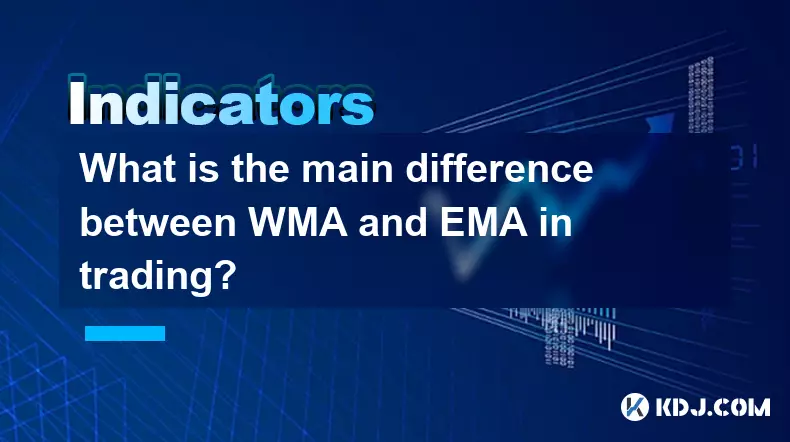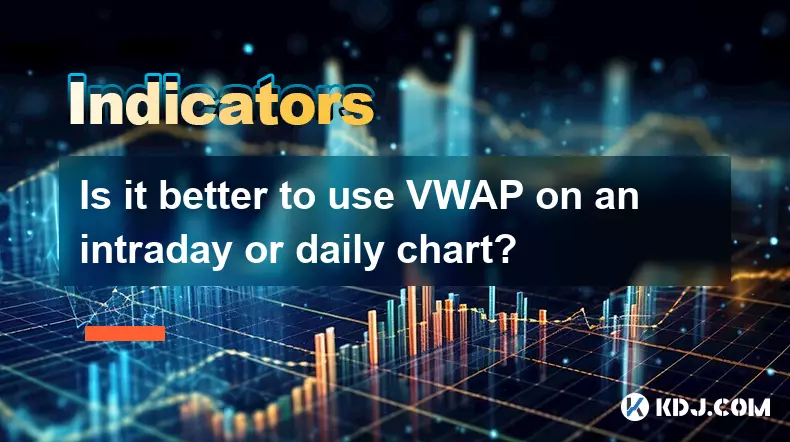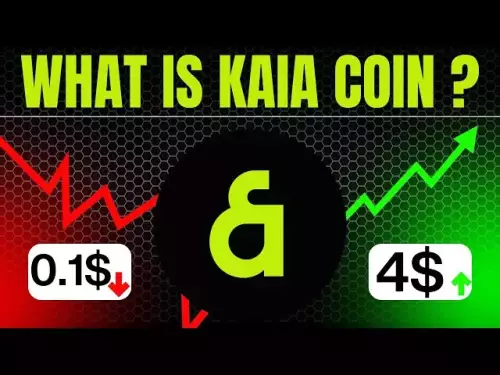-
 bitcoin
bitcoin $112715.707551 USD
-1.71% -
 ethereum
ethereum $4101.475385 USD
-3.01% -
 tether
tether $1.000644 USD
-0.02% -
 bnb
bnb $1207.619465 USD
-6.77% -
 xrp
xrp $2.501451 USD
-3.98% -
 solana
solana $202.947124 USD
-3.32% -
 usd-coin
usd-coin $1.000295 USD
0.04% -
 dogecoin
dogecoin $0.203884 USD
-4.47% -
 tron
tron $0.317154 USD
-1.72% -
 cardano
cardano $0.695009 USD
-4.43% -
 hyperliquid
hyperliquid $38.853961 USD
-8.23% -
 chainlink
chainlink $18.988674 USD
-4.64% -
 ethena-usde
ethena-usde $1.000233 USD
-0.03% -
 stellar
stellar $0.337050 USD
-3.63% -
 bitcoin-cash
bitcoin-cash $536.861728 USD
-1.28%
What is the main difference between WMA and EMA in trading?
The EMA reacts faster to price changes than the WMA, making it ideal for volatile markets like crypto, while WMA offers a balanced, linear weighting approach.
Oct 13, 2025 at 09:36 pm

Understanding Weighted Moving Averages (WMA)
1. The Weighted Moving Average (WMA) assigns a specific weight to each price point in the data set, with more recent prices receiving higher weights than older ones. This method uses a linear weighting system, meaning the most recent data point gets the highest multiplier, and each preceding point receives a progressively smaller value.
2. Traders use WMA when they want to emphasize the importance of recent price movements while still incorporating historical data in a structured way. Because the weights decrease uniformly, the influence of past prices diminishes at a steady rate.
3. One limitation of WMA is that it only considers a fixed window of data. Once a price point falls outside this range, it no longer impacts the average. This can lead to sudden shifts in the indicator when an outlier exits the calculation window.
4. WMA is less responsive compared to some other moving averages because its weighting scheme, although tilted toward recent data, doesn’t exponentially amplify the latest changes. It’s often used in conjunction with volume analysis or other trend confirmation tools.
Analyzing Exponential Moving Averages (EMA)
1. The Exponential Moving Average (EMA) also prioritizes recent prices but does so using an exponential decay formula. Unlike WMA, EMA incorporates all available historical data, giving decreasing yet never-zero weight to older prices.
2. This continuous inclusion of past data makes EMA smoother over time and less prone to abrupt changes caused by dropping old values out of a fixed window. The smoothing factor, typically derived from a chosen period, determines how quickly the weights decline.
3. Because EMA reacts faster to new information, it is widely favored in fast-moving markets such as cryptocurrency trading. Short-term traders rely on EMA crossovers for timely entry and exit signals.
4. The calculation complexity of EMA is slightly higher than WMA due to its recursive nature—it depends on the previous period’s EMA value to compute the current one. However, modern charting platforms handle this automatically, making it accessible to all traders.
Key Differences in Application and Sensitivity
1. The primary distinction lies in sensitivity: EMA responds more quickly to price changes than WMA, making it better suited for volatile assets like Bitcoin or Ethereum. This heightened reactivity allows traders to catch trends earlier, though it may also increase false signals during sideways markets.
2. WMA offers a balanced approach by reducing lag without fully discarding older data abruptly. It provides a compromise between the simplicity of a Simple Moving Average (SMA) and the agility of EMA.
3. In backtesting scenarios, EMA-based strategies tend to generate more frequent trading signals, which can be advantageous in trending environments but costly in choppy conditions due to increased transaction frequency.
4. Chart analysts often overlay multiple EMAs (e.g., 9-period and 21-period) to identify momentum shifts, while WMAs are more commonly used in specialized indicators or custom algorithms where precise linear weighting is required.
Common Questions About WMA and EMA
Q: Can WMA and EMA be used together effectively?Yes. Some traders combine both indicators to confirm signals. For instance, a crossover above the EMA might be validated only if the price is also above the WMA, reducing noise.
Q: Which moving average is better for day trading in crypto markets?EMA is generally preferred for day trading due to its faster response to price fluctuations. Its ability to track rapid momentum changes aligns well with the high volatility seen in digital asset markets.
Q: Do institutional traders favor EMA over WMA?Many institutions incorporate EMA into their technical models because of its responsiveness and widespread adoption. However, proprietary systems may use customized versions of WMA for specific analytical purposes.
Q: How do I choose the right period for EMA or WMA?The choice depends on trading style. Shorter periods (like 9 or 12) suit scalpers, while longer periods (50 or 200) are common among swing and position traders. Testing different settings on historical data helps determine optimal values.
Disclaimer:info@kdj.com
The information provided is not trading advice. kdj.com does not assume any responsibility for any investments made based on the information provided in this article. Cryptocurrencies are highly volatile and it is highly recommended that you invest with caution after thorough research!
If you believe that the content used on this website infringes your copyright, please contact us immediately (info@kdj.com) and we will delete it promptly.
- MEXC's Explosive Growth: Trading Volume and Token Gains in Focus
- 2025-10-15 18:25:16
- Pudgy Penguins Price Prediction: Bull Flag Hints at Breakout!
- 2025-10-15 18:45:14
- GateToken Q3 2025 Onchain Destruction: Deflationary Strategy in Action
- 2025-10-15 18:45:14
- Chainlink (LINK): Super Bullish Signals Amidst Institutional Adoption
- 2025-10-15 18:25:16
- Arbitrum (ARB) Comeback: Is a Price Surge on the Horizon?
- 2025-10-15 19:05:12
- Coinbase's India Crypto Play: A Bullish Bet on CoinDCX and the Future of Digital Assets
- 2025-10-15 18:30:01
Related knowledge

What's the main difference between VWAP and TWAP?
Oct 12,2025 at 11:54am
Understanding VWAP and Its Role in Crypto Trading1. Volume Weighted Average Price (VWAP) is a trading benchmark that calculates the average price of a...

How do you identify exhaustion moves using VWAP and its bands?
Oct 12,2025 at 08:00am
Understanding the Role of Decentralized Exchanges in Crypto Trading1. Decentralized exchanges (DEXs) operate without a central authority, allowing use...

Is it better to use VWAP on an intraday or daily chart?
Oct 15,2025 at 02:01am
Intraday Trading and the Role of VWAP1. Intraday traders frequently rely on VWAP (Volume Weighted Average Price) as a dynamic benchmark for assessing ...

How do you use VWAP to scale in and out of positions?
Oct 14,2025 at 02:19am
Understanding VWAP as a Dynamic Benchmark1. The Volume Weighted Average Price (VWAP) is not just an indicator—it functions as a dynamic benchmark that...

What are the main advantages of using VWAP over EMA?
Oct 11,2025 at 02:18am
Main Advantages of Using VWAP Over EMA1. Volume-Weighted Average Price (VWAP) incorporates trading volume into its calculation, offering a more accura...

How do you use VWAP on different chart types like Heikin Ashi?
Oct 11,2025 at 05:01pm
Understanding VWAP in the Context of Heikin Ashi Charts1. The Volume Weighted Average Price (VWAP) is a powerful analytical tool commonly used by trad...

What's the main difference between VWAP and TWAP?
Oct 12,2025 at 11:54am
Understanding VWAP and Its Role in Crypto Trading1. Volume Weighted Average Price (VWAP) is a trading benchmark that calculates the average price of a...

How do you identify exhaustion moves using VWAP and its bands?
Oct 12,2025 at 08:00am
Understanding the Role of Decentralized Exchanges in Crypto Trading1. Decentralized exchanges (DEXs) operate without a central authority, allowing use...

Is it better to use VWAP on an intraday or daily chart?
Oct 15,2025 at 02:01am
Intraday Trading and the Role of VWAP1. Intraday traders frequently rely on VWAP (Volume Weighted Average Price) as a dynamic benchmark for assessing ...

How do you use VWAP to scale in and out of positions?
Oct 14,2025 at 02:19am
Understanding VWAP as a Dynamic Benchmark1. The Volume Weighted Average Price (VWAP) is not just an indicator—it functions as a dynamic benchmark that...

What are the main advantages of using VWAP over EMA?
Oct 11,2025 at 02:18am
Main Advantages of Using VWAP Over EMA1. Volume-Weighted Average Price (VWAP) incorporates trading volume into its calculation, offering a more accura...

How do you use VWAP on different chart types like Heikin Ashi?
Oct 11,2025 at 05:01pm
Understanding VWAP in the Context of Heikin Ashi Charts1. The Volume Weighted Average Price (VWAP) is a powerful analytical tool commonly used by trad...
See all articles


























![Staking ATH: How To Stake $ATH in October 2025 with 523% APY — [Step-By-Step Guide] Staking ATH: How To Stake $ATH in October 2025 with 523% APY — [Step-By-Step Guide]](/uploads/2025/10/15/cryptocurrencies-news/videos/staking-ath-stake-ath-october-apy-stepstep-guide/68eef94d80903_image_500_375.webp)















































